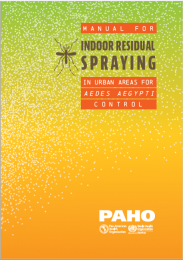Manual for Indoor Residual Spraying in Urban Areas for Aedes aegypti Control

Review / Resumen:
The seriousness of the current epidemiological situation of Aedes-borne viruses in Latin America, marked by co-circulation of dengue, chikungunya, and Zika viruses, the emergence of epizootics of yellow fever, and the occurrence of cases of microcephaly and other associated illnesses (e.g., Guillain-Barré syndrome), led the World Health Organization (WHO) to declare an emergency in the Americas in 20161. Given the absence of a specific treatment and vaccines against dengue, chikungunya, and Zika and the limitations of current vector control strategies, WHO urged greater use of the available alternatives for improving control of the Aedes aegypti mosquito vector, together with complementary activities. Added to this was the problem of maintaining adequate and uniform yellow fever vaccination coverage in endemic urban centers, a situation that carried the risk of urban circulation of that disease … The Manual for Indoor Residual Spraying in Urban Areas for Aedes aegypti Control is intended not only for operational personnel and middle and senior management of programs responsible for the prevention and control of Aedes-borne diseases, but also for the academic community involved in Aedes research, private pest control personnel, and the general public.
